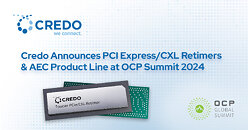TheLostSwede
News Editor
- Joined
- Nov 11, 2004
- Messages
- 18,472 (2.47/day)
- Location
- Sweden
| System Name | Overlord Mk MLI |
|---|---|
| Processor | AMD Ryzen 7 7800X3D |
| Motherboard | Gigabyte X670E Aorus Master |
| Cooling | Noctua NH-D15 SE with offsets |
| Memory | 32GB Team T-Create Expert DDR5 6000 MHz @ CL30-34-34-68 |
| Video Card(s) | Gainward GeForce RTX 4080 Phantom GS |
| Storage | 1TB Solidigm P44 Pro, 2 TB Corsair MP600 Pro, 2TB Kingston KC3000 |
| Display(s) | Acer XV272K LVbmiipruzx 4K@160Hz |
| Case | Fractal Design Torrent Compact |
| Audio Device(s) | Corsair Virtuoso SE |
| Power Supply | be quiet! Pure Power 12 M 850 W |
| Mouse | Logitech G502 Lightspeed |
| Keyboard | Corsair K70 Max |
| Software | Windows 10 Pro |
| Benchmark Scores | https://valid.x86.fr/yfsd9w |
Credo Technology Group Holding Ltd (Credo), an innovator in providing secure, high-speed connectivity solutions that deliver improved energy efficiency as data rates and corresponding bandwidth requirements increase throughout the data infrastructure market, is excited to announce the company's first Toucan PCI Express (PCIe) 6, Compute Express Link (CXL) 3.x and Magpie PCIe 7, CXL 4.x retimers and OSFP-XD 16x 64GT/s (1 Tb) PCIe 6/CXL HiWire AECs. Credo will demonstrate the Toucan PCIe 6 retimers and HiWire AECs at the upcoming Open Compute Project (OCP) Summit October 15-17 in Booth 31 and the OCP Innovation Center.
Building on Credo's renowned Serializer/Deserializer (SerDes) technology, the new PCIe 6 and PCIe 7 retimers deliver industry-leading performance and power efficiency while being built on lower cost, more mature process nodes than competing devices. Credo will also include enhanced diagnostic tools, including an embedded logic analyzer and advanced SerDes tools driven by a new GUI designed to enable rapid bring up and debug of customer systems.

"Credo is excited to extend our leadership into a new category of high-speed connectivity with the introduction of the Toucan PCIe 6 and Magpie PCIe 7 retimers," said Phil Kumin of Credo, Associate Vice President of PCIe Product. "By leveraging a mature process technology node, we are well positioned to achieve a cost advantage over our competition. Furthermore, with our SerDes already under evaluation on Tier 1 reference platforms, Credo is well positioned to capitalize on the AI industry's transition to PCIe 7 and take advantage of the throughput improvement."
"As PCIe speeds climb to 64 GT/s and 128 GT/s, retimers are increasingly critical components," said Dr. Debendra Das Sharma, Intel Senior Fellow, Chief Architect of I/O Technology and Standards in the Data Center Platforms and Artificial Intelligence Group at Intel Corporation. "As a leader in PCIe, we commend Credo for their investment in PCIe 6/CXL 3.x and PCIe 7/CXL 4.x retimers and we're excited to collaborate with them on pre-silicon co-simulation."
Credo's Toucan PCIe 6/CXL 3.x retimer, based on the TSMC N7 process technology, will sample in Q4, 2024. Toucan offers a full DSP SerDes to support PAM4 PCIe channels up to 43dB, enhanced diagnostic tools including an embedded logic analyzer, and x16 power of 11 W. Credo's Magpie PCIe 7/CXL 4.x retimer, based on the TSMC N5 process node, will begin sampling in H2 2025.
View at TechPowerUp Main Site | Source
Building on Credo's renowned Serializer/Deserializer (SerDes) technology, the new PCIe 6 and PCIe 7 retimers deliver industry-leading performance and power efficiency while being built on lower cost, more mature process nodes than competing devices. Credo will also include enhanced diagnostic tools, including an embedded logic analyzer and advanced SerDes tools driven by a new GUI designed to enable rapid bring up and debug of customer systems.

"Credo is excited to extend our leadership into a new category of high-speed connectivity with the introduction of the Toucan PCIe 6 and Magpie PCIe 7 retimers," said Phil Kumin of Credo, Associate Vice President of PCIe Product. "By leveraging a mature process technology node, we are well positioned to achieve a cost advantage over our competition. Furthermore, with our SerDes already under evaluation on Tier 1 reference platforms, Credo is well positioned to capitalize on the AI industry's transition to PCIe 7 and take advantage of the throughput improvement."
"As PCIe speeds climb to 64 GT/s and 128 GT/s, retimers are increasingly critical components," said Dr. Debendra Das Sharma, Intel Senior Fellow, Chief Architect of I/O Technology and Standards in the Data Center Platforms and Artificial Intelligence Group at Intel Corporation. "As a leader in PCIe, we commend Credo for their investment in PCIe 6/CXL 3.x and PCIe 7/CXL 4.x retimers and we're excited to collaborate with them on pre-silicon co-simulation."
Credo's Toucan PCIe 6/CXL 3.x retimer, based on the TSMC N7 process technology, will sample in Q4, 2024. Toucan offers a full DSP SerDes to support PAM4 PCIe channels up to 43dB, enhanced diagnostic tools including an embedded logic analyzer, and x16 power of 11 W. Credo's Magpie PCIe 7/CXL 4.x retimer, based on the TSMC N5 process node, will begin sampling in H2 2025.
View at TechPowerUp Main Site | Source

